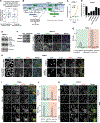Undermining Glutaminolysis Bolsters Chemotherapy While NRF2 Promotes Chemoresistance in KRAS-Driven Pancreatic Cancers
- PMID: 31911550
- PMCID: PMC7185043
- DOI: 10.1158/0008-5472.CAN-19-1363
Undermining Glutaminolysis Bolsters Chemotherapy While NRF2 Promotes Chemoresistance in KRAS-Driven Pancreatic Cancers
Abstract
Pancreatic cancer is a disease with limited therapeutic options. Resistance to chemotherapies poses a significant clinical challenge for patients with pancreatic cancer and contributes to a high rate of recurrence. Oncogenic KRAS, a critical driver of pancreatic cancer, promotes metabolic reprogramming and upregulates NRF2, a master regulator of the antioxidant network. Here, we show that NRF2 contributed to chemoresistance and was associated with a poor prognosis in patients with pancreatic cancer. NRF2 activation metabolically rewired and elevated pathways involved in glutamine metabolism. This curbed chemoresistance in KRAS-mutant pancreatic cancers. In addition, manipulating glutamine metabolism restrained the assembly of stress granules, an indicator of chemoresistance. Glutaminase inhibitors sensitized chemoresistant pancreatic cancer cells to gemcitabine, thereby improving the effectiveness of chemotherapy. This therapeutic approach holds promise as a novel therapy for patients with pancreatic cancer harboring KRAS mutation. SIGNIFICANCE: These findings illuminate the mechanistic features of KRAS-mediated chemoresistance and provide a rationale for exploiting metabolic reprogramming in pancreatic cancer cells to confer therapeutic opportunities that could be translated into clinical trials. GRAPHICAL ABSTRACT: http://cancerres.aacrjournals.org/content/canres/80/8/1630/F1.large.jpg.
©2020 American Association for Cancer Research.
Conflict of interest statement
Disclosure of Potential Conflicts of Interest
Dr. Frank McCormick is a consultant for the following companies: Aduro Biotech, Amgen, Daiichi Ltd, Ideaya Biosciences, Kura Oncology, Leidos Biomedical Research, Inc., PellePharm, Pfizer Inc., PMV Pharma, Portola Pharmaceuticals, and Quanta Therapeutics. Dr. McCormick has received research grants from Daiichi Sankyo Ltd and is a recipient of funded research from Gilead Sciences. Dr. McCormick is a consultant and co-founder for the following companies (with ownership interest including stock options): BridgeBio, DNAtrix Inc., Olema Pharmaceuticals, Inc., and Quartz. Dr. McCormick is Scientific Director of the NCI Ras Initiative at Frederick National Laboratory for Cancer Research/Leidos Biomedical Research, Inc.
Figures






References
-
- Grasso C, Jansen G, Giovannetti E. Drug resistance in pancreatic cancer: Impact of altered energy metabolism. Crit Rev Oncol Hematol 2017;114:139–52 - PubMed
Publication types
MeSH terms
Substances
Grants and funding
LinkOut - more resources
Full Text Sources
Other Literature Sources
Medical
Molecular Biology Databases
Miscellaneous

